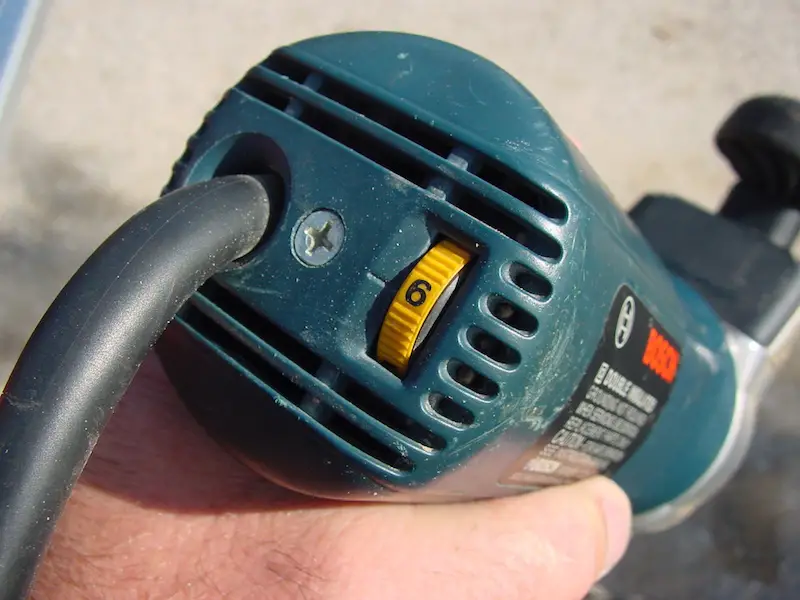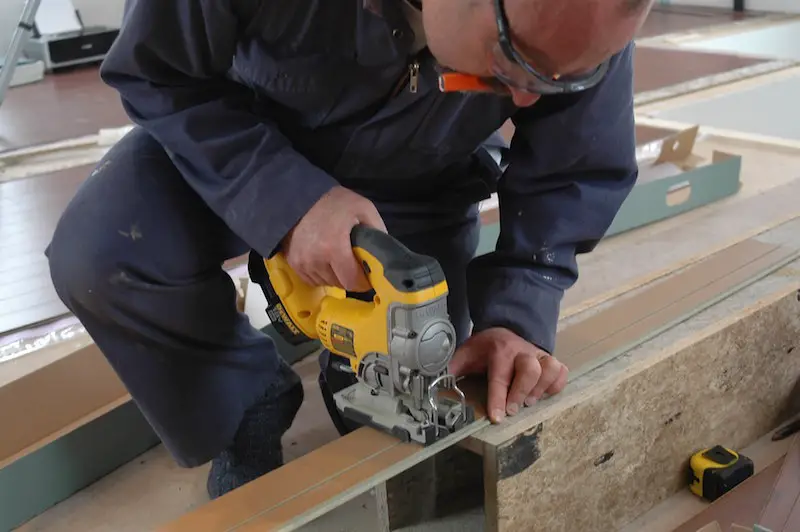
Jigsaws are hand-held power tools meant for cutting curved shapes in wood and metal. This article will help you understand the details of tool design and choice, but first a story . . .
As a teenager in the 1970s, I naturally believed that a jigsaw was a hand-held power tool. But my early experiences with one particular jigsaw left me thinking I was actually using a small arc welder. The tool was an economy model, and not up to the task of cutting the 1-inch thick oak I was working with. The project was a butler’s tray table – one of the first serious designs I’d taken on for a customer – and the design included four curved leaves that tilted up for carrying the tray around, then flipped down for serving. This translated into lots of tough curved cutting, mostly along the wood grain. Tough work. Blue sparks and a mushroom cloud of acrid smoke marked the tool’s last gasp during that job.
This experience didn’t quite set my clothes on fire, but it did kindle a renewed conviction that the only power tools worth owning are good ones. And choosing well often means paying more than bargain-basement prices. The first thing you need to understand before you buy is that jigsaw quality varies enormously across the board. There are some wonderful machines out there and some absolutely terrible ones. Be warned.
How to Choose a Jigsaw: Orbital Blade Action
Why do I like jigsaws? Lots of reasons. They’re safe, relatively quiet power saws that cut wood, plastic and even metal with an oscillating blade that moves up and down. They’re ideal for light home renovations, crafts and curved woodworking cuts. And if you and I were walking the aisles of a big box hardware store looking to choose your first jigsaw, I’d start by sharing philosophy. I’ve always found that having a solid philosophy that reflects reality is key for everything in life.
I’ve come to believe that buying one good power tool is cheaper and more efficient than buying three or four mediocre ones over the course of your life. And in the spirit of this quality quest, the first thing to look for in a jigsaw is orbital blade action. This is an adjustable feature that allows the blade of a saw to move in a D-shaped pattern during each cutting stroke, instead of only just straight up and down. The result is a much faster cutting action in wood and plastic than you’d get with straight line blade movement. In fact, you’ll work through material about three times faster with orbital action than you will without it, all else being equal. The trade-off (and there always is one) is that a D-shaped blade pattern also yields a rougher cut. That’s why all orbital jigsaws can be adjusted to offer no orbit at all (smooth but slower cutting), all the way up to maximum orbit for fast action through rough materials where smoothness doesn’t count. At its maximum orbital setting, the D-shaped blade pattern is extreme enough that you can see it happen. The blade moves straight down along the back of the D, then curves outwards as it moves up along the front of the D.
Click below to watch a video I made back in 2009 that shows orbital blade action on a jigsaw.
- Video Watch Time = 2 minutes
How to Choose a Jigsaw: Variable Speed, Body & Blade Style

Variable speed is another useful jigsaw feature because it enhances tool versatility. While it’s handy to be able to slow down blade action when slugging through thick hardwood, it’s absolutely essential to pull back on speed dramatically when slicing through plastics and metal. A single speed machine offers less potential because it can’t tackle the full range of materials that a variable speed jigsaw can.
Besides speed adjustment capabilities, jigsaws also divide into two groups based on how you hold them. Barrel grip saws have no actual handle, but rather a small diameter body that you grip with your dominant hand, and a mushroom knob above the blade for your other hand. Top-grip saws are different. They have a larger body with a handle that arcs above it. Good jigsaws are offered in both formats, though I usually prefer the barrel grip. Hold both when you’ve in the store before you buy.

Any jigsaw is only as good as its blade, and the saw you choose affects the choice of blades available off the shelf. The most popular of these is the so-called “Bosch” style, named after the company that made it popular. You’ll find that the best blades most often only come with this style of anchoring flange. Good jigsaw blades aren’t cheap, either. Expect to pay a couple of dollars or more each, but their performance is worth it.
Even a good jigsaw can’t cut everything. One limitation is power. Even a heavy-duty machine has to work hard to cut through 2-inch thick hardwood, especially parallel to the grain where the going gets tough. That’s where you’ll need to use a coarse blade. Another limitation is accuracy. Since the blades of all jigsaws are only supported on their top ends, the bottom end is free to wander a little from side-to-side during a cut. And wander it will. This can be minimized by using a sharp blade with the correct tooth spacing, but the tendency for blade wander never completely disappears. That’s why you can’t count on jigsaws to create a cut with an absolutely square edge. For that you need a hand-held circular saw or a table saw.
How to Choose a Jigsaw: Buying Checklist Recap
When assessing jigsaws in the store, look for:
- Orbital blade action to speed cuts through rough material.
- A motor that draws between 4 and 5 amps according to the name plate on the tool.
- Variable speed capabilities that allow blade movement to be reduced to a frequency of one or two cycles per second
- A couple of dozen different kinds of blades that fit the machine.
- A carrying case that holds blades, wrenches, instruction manual and goodies.
Good tools are like good friends. The more success you experience together, the more you like them. I bought my first professional-grade jigsaw in 1988, and it’s seen me through many professional and DIY jobs. I also lend it out to friends who always say what a joy it was to use. And isn’t that what you’d expect from a good tool?












